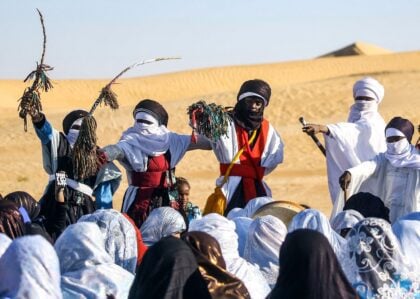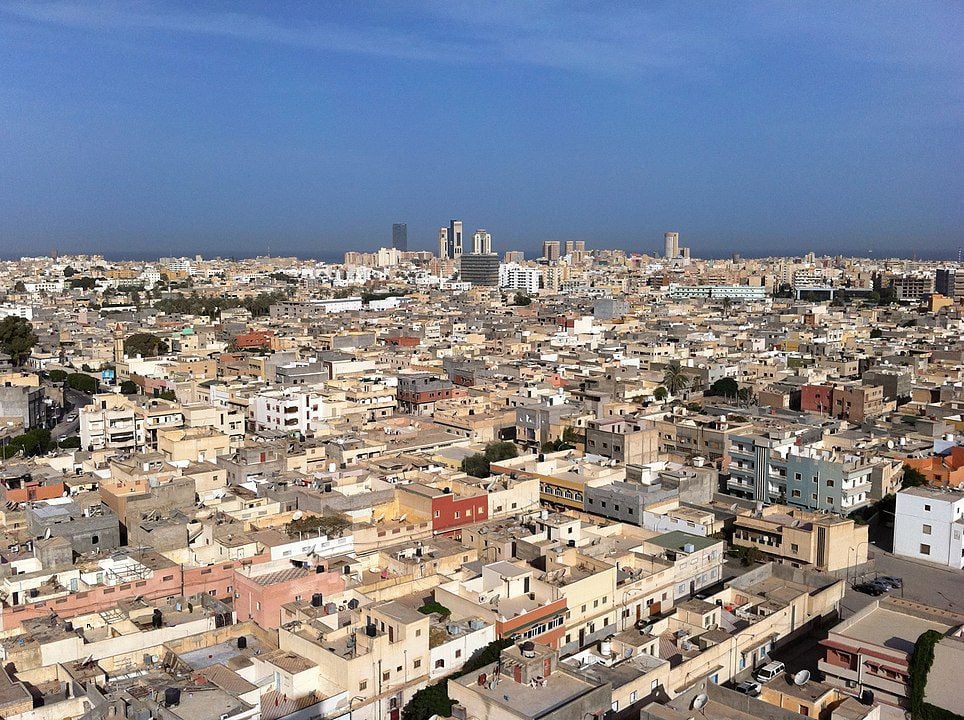
Introduction
In mid-2020, the population of Libya was estimated to be about 6.87 million according to World Bank data, and the number of males reached 3.47 million, or 50.48% of the total population, while the number of females reached about 3.40 million, or 49.52%, with a gender ratio of 102 males per 100 female.
The country’s annual population growth rate was 1.33%, compared to 2019, which in turn recorded a population increase rate of 1.48%, according to World Bank data. Immigrants accounted for about 12% of the total population in 2019.
Arabs and Berbers (Berbers) constitute 97% of the total population in Libya (Berbers 5%), while the remaining 3% include (Syrians, Greeks, Maltese, Italians, Pakistanis, Turks, Tunisians, and Indians). According to the CIA World Factbook.
Arabic is the official language of the country, while Italian and English are widely understood in major cities. As well as the Berber languages (Nefousi, Ghadames, Sokhna, Awjila, and Tamashek) Sunni Muslims represent 96.6% of the total population, while Christians represent 2.7%, Buddhists 0.3%, Hindus <0.1, Jews <0.1, popular religions <0.1, non-religious 0.2%, others <0.1. Non-Sunni Muslims include indigenous Ibadi Muslims (less than 1% of the population) and Muslim foreigners (2010 estimates).
The Libyan revolution in 2011 led to a drastic reduction in migration and forced about 800,000 migrants to flee to third countries, especially Tunisia and Egypt, or to their countries of origin. The flow of immigrants decreased in 2012, but returned to normal levels by 2013, despite persistent hostility to sub-Saharan Africans and the less attractive job market.
Although Libya is not an attractive destination for migrants, transit migrants – from the East and mainly East Africa – have continued since 2014 to exploit its political instability and weak border controls and use it as a major departure point for migration across the central Mediterranean to Europe in numbers. Mounting. In addition, more than 200,000 people have been internally displaced as of August 2017 due to fighting between armed groups in eastern and western Libya, and to a lesser extent, due to tribal clashes in the south of the country.

Age Groups
In terms of the age structure of the population, and in the absence of any official statistics as a result of the ongoing violence in the country and the state of political instability, more than a quarter of the population (33.55%) does not exceed the age of 14 years in 2020 AD, according to the “World Factbook” of the American Central Intelligence Agency. ; While 56.78% of the total population is in the age group (15-54 years), 5.52% is between (55-64 years), while 4.04% are 65 years and over.
The estimated fertility rate in 2021 AD was 3.13 births/woman. The average life expectancy at birth in the same year was 76.93 years (74.68 years for males and 79.29 years for females).
Areas of Habitation
More than 90% of the population lives along the Mediterranean coast between Tripoli to the west and Al-Bayda to the east. The interior regions still suffer from a significant shortage of people due to desert and water shortages.
According to the “World Factbook” of the CIA, the urban population constitutes about 80.7% of the total population, according to 2020 estimates. Where the capital, Tripoli, acquires 1.19 million; While Benghazi ranks second in terms of population, with about 821.5 thousand people. Then Misurata with 823.3 thousand.
The population density was 3.91 people/km2 in 2020 CE, while it recorded 3.19 people / km2 in 2019 CE and 3.52 people / km2 in 2010 CE before the outbreak of the last revolution in Libya, distributed unequally; In coastal areas, where the bulk of the population lives.

Ethnic Groups
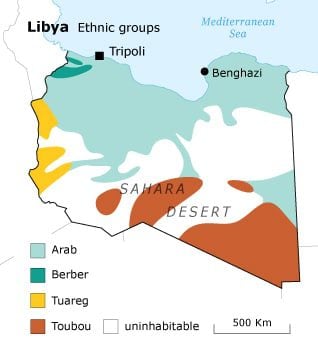
Demographically, Libya’s population is much more homogenous than that of other countries in North Africa. Estimates vary, but most sources indicate that 92 percent of the people are of Arab origin.
Imazighen (Berbers)
5 percent of the total population is Imazighen, also known as Berbers, a name that comes from the Latin barbari, used by the Romans for all people outside the Greco-Latin sphere. Because Imazighen tribes long resisted Roman domination on the coast, the name was applied especially to them. It was later used by Muslim writers, most famously Ibn Khaldun, one of whose main works is entitled Kitab al-ibar (Book of Lessons). The term was adopted by Europeans, who often referred to North Africa as ‘Barbary’ until the beginning of the 20th century. The Berber term amazigh (plural imazighen) means ‘free people’.
As Libyan place names show, the Imazighen/Berbers were once dominant in the region, but today the largest communities are to be found in the Jebel Nafusa region, the Jifara plain, and Zuwara.
Traditional Amazigh society was a settled agricultural economy involving cattle herding and the cultivation of olive oil and grains. In Jebel Nafusa villages such as Nalut, Gasr al-Hajj (Qasr al-Haj), Yafran, Jadu, and Kabaw, ancient qasrs (fortified granaries) and olive presses remain from this period. The region is a major tourist attraction. Only a few Berbers still lead a semi-nomadic life.
The Berber languages, known collectively as Tamazight, belong to the Afro-Asiatic language family. The Berber languages are related to the ancient Egyptian and Semitic languages. The Tifinagh script is derived from the Punic alphabet of the Phoenicians but is rarely used, except by the Tuareg, who are also of Amazigh origin, in writing their language, Tamasheq, but individual letters are often used as tattoos on Berber women’s hands and face, and on pottery, rugs, and jewellery. Libyan Berbers are nearly all bilingual, although there are said to be people who only speak Berber in Awjila, south of Ajdabiya.
Historically, the Berbers were marginalized from government and politics which were centred in Arabic-speaking – or, under the Ottomans, Turkish-speaking – towns, although Sulaiman al-Barouni, from the Jebel Nafusa, was President of the short-lived Tripolitanian Republic in 1919.
Gaddafi
Under the Gaddafi regime, Amazigh culture was repressed. It did not fit with the main official narrative that emphasized Arab Bedouin identity. In international speeches, Gaddafi denied the existence of Imazighen/Berbers, calling them Berber Arabs. Parents were not allowed to give their children Amazigh names. At the end of the 20th century, however, a regional Amazigh movement emerged to seek recognition of Amazigh identity and socio-cultural rights, and an international Amazigh flag was designed. As part of this development, Libyan Imazighen/Berbers became more empowered and consciously propagated their identity, language, and culture, especially on the Internet. Lobbying at the United Nations resulted in Amazigh names, such as Numidia and Massinissa, finally being allowed.
Following the fall of the Gaddafi regime, Amazigh activism was openly expressed, and Amazigh individuals took on more prominent roles. In June 2013, Nouri Abusahmain was elected President of the General National Congress. He represents Zuwara, on the Tunisian border, and is the first member of the Amazigh community since al-Barouni to win a leadership role in Libya.
Tribes
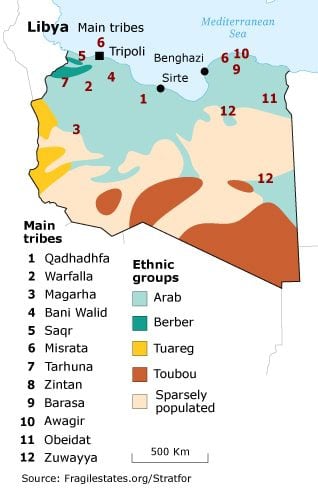
The tribe (qabila in Arabic, taqbilt in Tamazight) is, in theory, the largest group that claims descent from a common ancestor. In reality, this top level of descent is usually mythical, but genuine kinship links do exist at lower levels, the clans and lineages, which are functioning social and political networks. Kinship links are crucial to providing a structure for the division of land, pasture grounds, and access to water, mediating in disputes, and providing protection from outsiders. Although the borders between tribes, or between clans and lineages, are not formally marked, each group does have access to its own areas, and these are understood.
The tribe was historically the basis of social organization across North Africa, although structures changed over time. Many of the tribes that exist today trace their origins back to the 11th century, when the great tribal confederations of Banu Hilal and Banu Salim moved from the Arabian Peninsula to North Africa. The reasons for this migration have been much debated, but, as Ibn Khaldun demonstrated, an important result was to solidify in place both Islam and the Arabic language. Broadly speaking, the Banu Hilal settled in Tripolitania and the Banu Salim in Cyrenaica.
It has been estimated that there are approximately 140 different tribes (many of which have branches stretching over international frontiers into Tunisia to Egypt to Chad), but, according to Faraj Najem, a sociologist who has specialized in the study of Libyan tribes, no more than thirty wield any demonstrable influence (al-Sharq al-Awsat, 22 February 2011). By comparison with other North African countries, though, this influence is remarkable, and the reasons lie in the nature of the society that Gaddafi inherited and the policies he adopted in order to stay in power.
After the 1969 coup, Gaddafi announced that he wanted to end tribalism, and the country was divided into administrative zones that did not correspond to traditional tribal borders. Eventually, however, he came to rely on tribal relations: tribal affiliation, for instance, was important in obtaining employment in Gaddafi’s General People’s Committees or in the security apparatus.
Gaddafi’s revolutionary framework was centred on his own Qadhadhfa tribe. This was a minor tribe, but it was allied to the much larger Warfalla (near Bani Walid), Zuwayya (near Kufra), and Magarha tribes. Abdessalam Jalloud, Gaddafi’s second-in-command for at least two decades, was a prominent member of the Magarha, as was Abdelbaset al-Megrahi, who was found guilty of the Lockerbie bombings. The Warfalla supplied many personnel for Gaddafi’s security apparatus.
In eastern Libya, the largest and most influential tribes are the nine Saadi tribes that claim descent from the Banu Sulaym. Among the most powerful of all is the Barasa tribe, which is influential in Benghazi and Derna. Gaddafi’s wife Safia came from the Barasa. The other prominent tribes are the Awaqir, the Magharba, the Abid, the Urfa, the Ubaidat, the Hasa, the Fawaid, and the Dursa. The Awaqir played a prominent role in opposing Ottoman and Italian colonialism and later provided men who held senior positions within Gaddafi’s regime. The Misrata tribe, which is particularly influential in Benghazi and Derna, has links with the district of the same name in north-western Libya. It was largely opposed to the Gaddafi regime.
Some tribes have links across Libya. The Firjan tribe is centred west of Ajdabiya but has members in Sirte, Zliten, and Tripoli. There is also a branch in Tunisia, just as the Qadhadhfa has a branch in Egypt. The Zuwayya, Warfalla, Magarha, and Maslata dominate Fezzan but are also important in the hinterland of Tripoli. Most people in Tripoli itself are affiliated with the Misrata tribe, in which the Muntasir clan and the families of Suni, Qadi, and al-Bashti are prominent.
In addition, there are mixed Arab-Amazigh tribes called Marabtin, such as the Fawakhir, Mnifa, and Qatan. Marabtin tribes used the land as clients of dominant tribes. Two of these tribes, the Awlad Nuh and the Awlad al-Shaykh, live more independently and act as traditional mediators in disputes.
Tuareg and Toubou
The south-western Sahara is the domain of the Amazigh Tuareg, who speak Tamasheq. The original homeland of the Tuareg stretches from Libya, Niger, Algeria, and Mali to Mauritania. This group of originally semi-nomadic herdsmen is divided into two subgroups: the Teda in the north and the far more numerous Daza in the south. According to official figures, only 12,000 to 15,000 live in Libya, around Ghat, Ghadames, and Murzuq.
The nomadic Toubou community resides in the Tibesti Mountains, which are divided between Chad and Libya.
Religious Composition
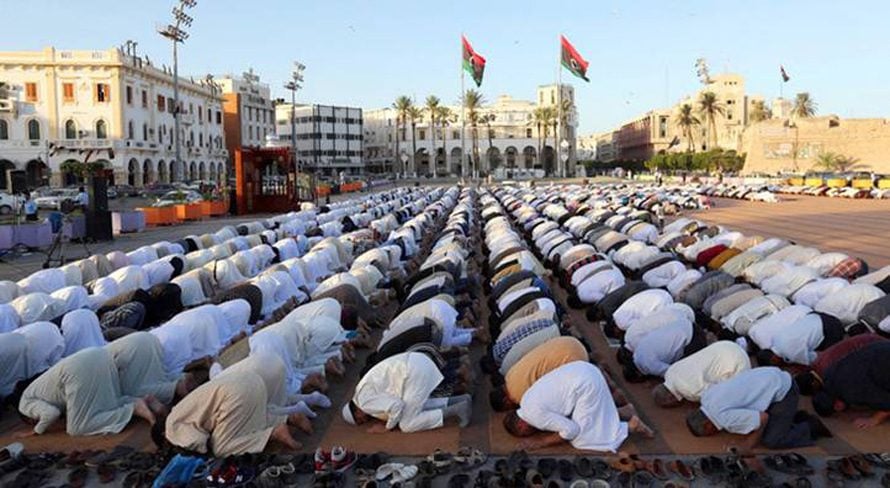
The majority of Libyans are Sunni Muslims and follow the Maliki school of law. Among the Berbers there is an unknown number of Ibadites. Tuareg are Sunni Muslims, although their religion also includes popular elements. Many nomadic cultures show less attachment to religious externals than do urban communities.
Libya also has small communities of Christians: Roman Catholics, Coptic Orthodox, and Anglicans have their own places of worship.
Ibadi Muslims
Among the Berbers of the Jebel Nafusa, there are an unknown numbers of Ibadi Muslims, a minority group that today is strongest in Oman and Zanzibar, with smaller communities in Algeria and Tunisia. Among the Libyan Berbers adherents do not always acknowledge their religious affiliation openly.
The Ibadis are said to stem from Kharijites. Their propagandists reached Tripolitania and later took root in the Jebel Nafusa, where they formed a local imamate that expanded briefly onto the coast in the mid-8th century before being forced back into the desert. After the 9th century, they were confined to isolated communities in the Mzab in Algeria, the island of Djerba in Tunisia, and the Jebel Nafusa.
Sufis
Sufism is the mystical discipline of Islam, in which the personal relation and experience with God is emphasized. In pre-colonial North Africa, Sufi adherents gathered into brotherhoods, and these orders became popular particularly in rural areas. There, they provided some of the structures that might otherwise have been provided by a centralized state: mediation in disputes, assistance to the poor, the encouragement of trade, and, particularly when the Ottoman Empire proved unable to mount effective resistance to the encroaching armies of Christian powers, a military organization. The most powerful brotherhood in Libya was the Senussi, which was based in eastern Libya.
Salafis
The Salafiya is a religious movement of reform that emerged in Islam in the 19th century. Its adherents (Salafis) believe that the ‘pious ancestors’ (salaf), who were associates of the Prophet Muhammad, should be the only model for later Muslims in matters of belief, worship, and conduct. They claim to practise an Islam that is pure and unadulterated. In the 20th century, these doctrines were increasingly directed against state governments that the Salafis deemed irreligious and, in the most extreme form, became a source of internal jihad.
After the 2011 revolt, a growing number of Salafi groups in Libya sought to profit from the unstable security situation that existed during the period of transitional government. Many members of Salafi militias subsequently refused to integrate themselves into the nascent government forces.
The most prominent Salafi group, Ansar al-Sharia, based in Benghazi, was formed from former rebels who shared a common Salafi ideology: they were involved especially in the protection of public places such as hospitals. Another centre for Salafi groups is eastern Libya, in cities such as Derna. Most groups have links with groups in other regions and countries, but it is not always clear to what extent they are actually involved in terrorism.
Salafism is often portrayed as ideologically synonymous with Saudi Wahhabism, yet even though Muhammad ibn Abd al-Wahhab himself is respected as an early proponent of the need to return to pure religious practices, hard-line Salafis are strongly opposed to personality cults. They regard shrines as idolatrous, and in 2011 and 2012 Salafi groups carried out a series of attacks on Sufi tombs, shrines, and mosques and on other religious communities, such as the Copts.
Jews
When the Italians colonized Libya in 1911, an estimated 21,000 Jews lived in Tripoli. Their history goes back to the 3rd century BCE, and they flourished during the Roman period by reaching an accommodation with their rulers.
The rise of fascism in Italy greatly disadvantaged the Jewish community economically and culturally, as it did Libyan Muslims, who faced their most severe repression under Mussolini’s Generals Pietro Badoglio and Rodolfo Graziani. However, Libyan Jews were generally spared the fate of their European counterparts because they were embedded in middle class and administrative positions. Even so, both Libyan Muslims and Jews ended up in Italian concentration and labour camps in Libya, and about a hundred Jews were sent to European concentration camps.
With the establishment of the Israeli state in 1948 and the 1967 June War, all remaining Libyan Jews migrated to Israel.
After 1969, Gaddafi adopted a pro-Palestinian stance and seized all Jewish properties. Officially, there are no longer any Jews in Libya. In 2004, Gaddafi promised to pay Jews compensation, on condition that they could show they did not hold possessions confiscated from Palestinians after 1948 or had returned them to their rightful owners.
Minorities
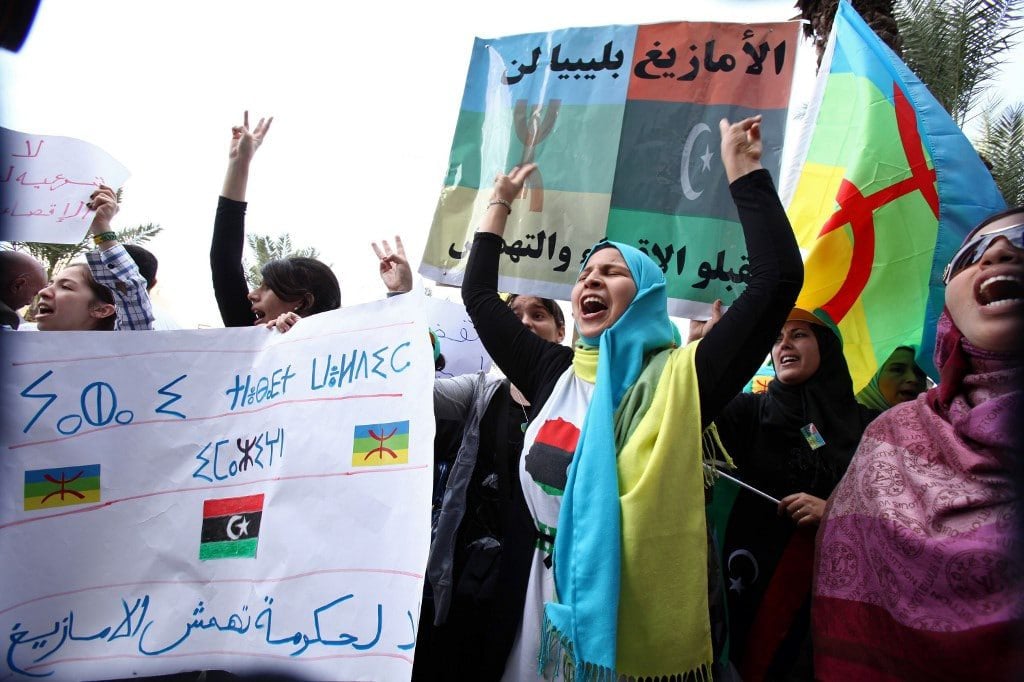
After the 2011 revolution, opponents of the Gaddafi regime viewed both the Tuareg and the Toubou as its accomplices, and ethnic relations worsened.
The reasons for this lie in changes associated with the progressive impoverishment of desert communities during the late 19th and the 20th centuries. The Tuareg are distinctive both in their common language, Tamasheq, and their dress (men are famed for wearing veils against the desert heat). Moreover, the nomadic lifestyle of many Tuareg had established kinship links across the Sahara, linking communities in what are now Libya, Algeria, and the western Sudanic countries. Their political system also provided them with a strong sense of identity. It was very hierarchical, with several ‘noble’ families, a majority of vassals, and a smaller class of black, non-Tuareg slaves who worked in agriculture and cattle herding. Status was essentially based on work as traders or warriors rather than on manual labour. In short, there was a wider ethnic identity that is historically independent of the modern state.
At the same time, these communities were diverse, with a variety of modes of production. Historically, some had lived by collecting protection fees from the trans-Sahara caravans or even by raiding settled communities in the oases or on the desert edges. Others were settled, either in the desert towns where they traded or as horticulturalists in the oases. In the late 19th century, the caravan trade diminished, and many Tuareg lost their main source of subsistence. As the power of colonial states increased, the opportunities for productive warfare decreased.
The early years of independence, in the 1960s and 1970s, coincided with severe droughts in the Sahara that decimated the Tuareg’s livestock. Many people had to give up their nomadic way of life and move to cities. Political tensions in Mali and Niger in the 1990s caused further migrations and a war in which Tuareg in Mali fought for more autonomy from the black Malian government. In these circumstances, many Tuareg sought refuge in Libya. The Gaddafi regime welcomed them, promising housing, education, development, and a national identity. Most of these promises went unfulfilled, and many second-generation Libyan Tuareg felt marginalized and increasingly disaffected. Many Tuareg never received Libyan identity papers.
By the later 20th century, the disaffection of a large and distinctive group had been institutionalized by the Gaddafi regime, which fuelled the growth of ethnic tensions when the 2011 revolution took place.
Toubou
The Toubou (also Tubu or Tibbu) are a nomadic community in the Tibesti Mountains in southern Libya and Chad, and they speak a Nilotic language, Tedaga, rather than a Semitic or Amazigh one. Numbering around 400,000, this group of originally semi-nomadic herdsmen is divided into two subgroups, the Teda in the north and the far more numerous Daza in the south. According to official figures, only 12,000 to 15,000 live in Libya. This is a family and clan-based society centred on oasis cultivation of dates and grain and transhumant herding of cattle.
The Gaddafi regime discriminated actively against the Toubou, subjecting them to forced displacement and denying them citizenship. After the war with Chad and the 1994 ruling by the International Court of Justice that obliged Gaddafi to hand back the Aouzou Strip, he declared that the Toubou were really Chadians. In the early 2000s they were denied basic public services. The regime demolished Toubou homes in Kufra and exiled residents to Chad. Toubou were not allowed to join the Armed Forces or the police, although they have done so since the 2011 revolution. It was not until April 2013 that a Toubou cultural festival could be held in Murzuq, as reported by the Libya Herald.
Discrimination Against Foreign Minorities
Like some other Arabic and nomadic societies, Libyans often esteem a white skin colour. Combined with the prevailing opinion that labour should be done by black Africans, this leads many Africans to feel that they are discriminated against.
Racial tensions reached a low point in 2000, when thousands of African migrants were attacked by unemployed Libyan youths. Some Africans sought refuge in embassies before being repatriated. In the 1990s, as the economic situation deteriorated and unemployment increased, resentment of Africans grew. This was exacerbated by Gaddafi’s use of African mercenaries in his army. They were enlisted initially in the Islamic Legion that he set up in the 1970s, which was composed mainly of migrants from poor Sahelian countries and used to support his military adventures in sub-Saharan Africa. Then, during the 2011 uprising, Gaddafi was reported to have employed mercenaries from Mali, Niger, and Chad against the rebels, promising to pay them for each rebel they killed. As a result, there was great public dislike of Africans in Libya.
Moroccan, Egyptian, and Palestinian labourers are also often held in contempt, to the extent that that many Arab labourers fled the country in 2011, depriving Libyan cities of essential services.
Foreign Minorities
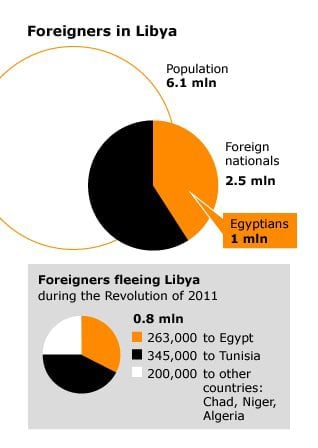
Exact numbers are not available, but in March 2011 the International Organization for Migration (IOM) estimated that, before the revolution, there were 2.5 million foreign nationals living in Libya. Between the beginning of the crisis in February 2011 and the end of that year, 796,915 migrants fled the violence, mostly to Egypt (263,554) and Tunisia (345,238), although others went south to Chad and Niger or to Algeria. Many made their way by boat to Italy and Malta. 318,007 were third-country nationals (TCN) whom the IOM assisted with onward passage to their own countries of origin. It was one of the largest migration crises in modern history. These foreign workers came from five main sources:
• Other North African countries: the IOM organized the repatriation of 136,749 Tunisians and 173,000 Egyptians in early 2011, although it estimated that there were 1 million Egyptians and 59,000 Sudanese resident before the risings. Egyptians worked in agriculture, construction, and food production (e.g. bakeries). Tunisians, Algerians, and Moroccans (estimated at 120,000 in 2004) were engaged especially in service industries (such as restaurants and cafés).
• South Asia: the IOM estimated pre-revolution populations of 80,000 Pakistanis and 63,000 Bangladeshis. They were mainly males between the ages of 26 and 35, employed in construction as carpenters, masons, and labourers.
• South-east: the IOM estimated pre-revolution populations of 26,000 Filipinos and 10,500 Vietnamese. Overseas Filipino workers (OFW) tended to be more skilled and were employed in oil refining, engineering, nursing, and domestic work.
• Southern Europe: principally Malta, Turkey, and Greece.
• What the IOM described as ‘a large population of Sub-Saharan Africans mainly from Niger, Chad, Mali, Nigeria and Ghana’. In the aftermath of the 2011 crisis, the IOM created a profile of Chadians who had fled to their home country: The majority were males aged between 18 and 35 who had never completed primary school and were working as unskilled labourers in construction and agriculture. Most had spent one to five years in Libya, but some families had been there for thirty years or more and had children born in Libya. Workers evacuated to Niger and Mali had similar profiles. In Fezzan, Africans also worked in farming and other agriculture.
Migrant work in Gaddafi’s Libya was always precarious, subject to the political whims of the regime. In 1977, many Egyptians were expelled, and, in 1985, 35,000 Tunisians. The most vulnerable were the victims of human trafficking. Two major smuggling routes, via Murzuq and Kufra, serve for the exchange of illicit weapons, petrol, and food, as well as drugs and alcohol. Most of these African migrants used Libya as a transit point on their way to Europe, but there were occasional reports of Africans being sold as slaves, even after the revolution of 2012. The IOM reported that migrants could be purchased for between 270 and 800 Libyan dinars, depending on nationality and type of work. Under Gaddafi, the Libyan government made no significant efforts to investigate and prosecute trafficking offenses or to protect trafficking victims but instead tended to punish the victims of trafficking.
After the July 2012 elections, the issue of migration was debated in the Assembly, with arguments being made either to deport or to legalize the foreign workers. Before the risings, there were 3,100 recorded refugees from Iraq and 2,700 from Palestine. Again, the status of these refugees was subject to arbitrary change as a result of temporary political considerations.
In 2011 there were 93,000 internally displaced persons due to the conflict between pro-Gaddafi and anti-Gaddafi forces. In 2012 the UNHCR stated that the Libyan government indicated its willingness to sign the 1951 Refugee Convention.
Socio-economic Composition
Figures for income distribution are impossible to obtain. Libya has never provided figures to the World Bank on per capita gross national income nor on wealth distribution by percentiles. In 1952, when Libya became independent, it was the poorest sovereign state in the world. By 1980, when a consistent series of International Monetary Fund (IMF) data begins, per capita GDP in current US dollars was USD 12,807 per annum. This fell to a low of USD 3,767 in 2002 before climbing again in 2007 and 2008. There was a marked fall again in 2011.
The Human Poverty Index of 2007 (UNDP) put Libya at 13.4, compared with Egypt (23.4) and Algeria (17.5) and the richer Arab Gulf states such as Oman (14.7) and Saudi Arabia (12.1). In general terms, Libya’s oil and gas wealth has produced a classification of ‘low human poverty’, but, according to Libyan sources, there is a large but unquantified difference in income between east and west, with Tripoli more prosperous than Benghazi in infrastructure, houses, schools, and hospitals. Cyrenaica seems generally to have been starved of investment during the Gaddafi era, although the oil that provides the wealth comes mainly from eastern Libya. In January 2003, the Libya Herald reported that the only sewage facility in Cyrenaica was no longer functioning, and other reports said it was more than forty years old. The relative deprivation in the east was the product of Libya’s history: the former royal regime was based in Cyrenaica, and, during the Gaddafi period, the major Islamic opposition came from the east. Dissatisfaction in Cyrenaica was a major factor triggering the 2011 revolt.
Latest Articles
Below are the latest articles by acclaimed journalists and academics concerning the topic ‘Population’ and ‘Libya’. These articles are posted in this country file or elsewhere on our website:



